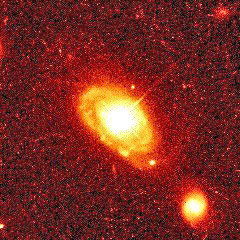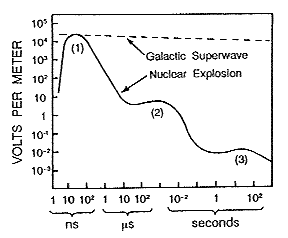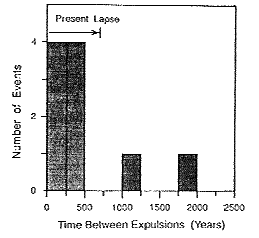|
|
|
by Paul LaViolette from Etheric Website
Galactic core outbursts are the most energetic phenomenon taking place in the universe.
The active, quasar-like core of spiral galaxy PG 0052+251 (Figure 1-a), for example, is seen to radiate 7 times as much energy as comes from all of the galaxy’s stars.
Most of this is emitted in the form of high energy cosmic ray electrons accompanied by electromagnetic radiation ranging from radio wave frequencies on up to X ray and gamma ray frequencies.
A study of astronomical and geological data reveals that cosmic ray electrons and electromagnetic radiation from a similar outburst of our own Galactic core (Figure 1-b), impacted our Solar System near the end of the last ice age.
This cosmic ray event spanned a period of several thousand years and climaxed around 14,200 years ago.
Although far less intense than the PG 0052+251 quasar outburst, it was, nevertheless, able to substantially affect the Earth’s climate and trigger a solar-terrestrial conflagration the initiated the worst animal extinction episode of the Tertiary period.
X-ray photo of the Sun showing solar flare hot spots.
The effects on the Sun and on the Earth’s climate were not due to the Galactic cosmic rays themselves, but to the cosmic dust that these cosmic rays transported into the Solar System.
Observations have shown that the Solar System is presently immersed in a dense cloud of cosmic dust, material that is normally kept at bay by the outward pressure of the solar wind. But, with the arrival of this Galactic cosmic ray volley, the solar wind was overpowered and large quantities of this material were pushed inward.
The Sun was enveloped in a cocoon of dust
that caused its spectrum to shift toward the infrared. In
addition, the dust grains filling the Solar System scattered
radiation back to the Earth, producing an "interplanetary
hothouse effect" that substantially increased the influx of
solar radiation to the Earth. Details of this scenario are
described in Paul LaViolette’s book
Earth Under Fire,(1) in his
Ph.D. dissertation,(2) as well as in a series of journal
articles he has published.(38)
These various solar effects caused
atmospheric warming and inversion conditions that facilitated
glacial growth which brought on ice age conditions. On occasions
when the solar radiation influx to the Earth became particularly
high, the ice age climate warmed, initiating episodes of rapid
glacial melting and continental flooding. There is evidence that
one particularly tragic solar flare event occurred around 12,750
years ago during a period when the Sun was particularly active.
This involved the release of an immense coronal mass ejection
which engulfed the Earth and induced a mass animal extinction.
He coined the word "galactic superwave" to refer to such a cosmic barrage. He has shown that
galactic superwaves recur at long intervals and arrive at
Earth’s doorstep without warning because they travel at near
light speed.
The cores of all spiral galaxies cycle through a similar phase. During its active period, our galactic core spews out a fierce quasar-like barrages of cosmic rays, with a total energy output equal to hundreds of thousands of supernova explosions.(10,11)
In some galaxies these active
emissions have been observed to equal the energy from billions
of supernova explosions.
Astronomical discoveries subsequently confirmed aspects of Dr. LaViolette’s hypothesis. In 1985, astronomers discovered that Cygnus X-3, an energetic celestial source of cosmic rays, which is about the same distance from Earth as the Galactic Center (25,000 light years), is showering Earth with particles, traveling at close to the speed of light, moving in essentially straight paths.(13)
Later,
scientists found the Earth is impacted, at sporadic intervals,
with cosmic rays emitted from the X-ray pulsar Hercules X-1
(about 12,000 light years distant).(14,15) The intervening
interstellar medium has so little effect on these particles,
that their pulsation period of 1.2357 seconds, is constant to
within 300 microseconds.
Data obtained from polar ice core samples show evidence of this cosmic ray event as well as other cosmic ray intensity peaks from earlier times (Figure 2).(1, 18)
Figure 2. Demonstration that cosmic ray intensity has varied considerably during the past hundred twenty thousand years. Lower profile: Cosmic ray intensity at the Earth's surface calculated from variations in the concentration of beryllium-10 in the ice record adjusted for changes in ice accumulation rate. Upper profile: Global temperature. Climatic zones include: the present interglacial (1), last ice age (2, 3, & 4),
previous
semi-glaciated period (5a-d), last interglacial (5e), and previous
glaciation (6).
Also Dr. LaViolette’s prediction that there is a residual flow
of interstellar dust currently entering the Solar System from
the Galactic center direction was later verified by data
collected from the Ulysses spacecraft and by AMOR radar
measurements made in New Zealand.(8)
We live on the edge of the Galaxy’s volcano.
Knowing neither the time, the magnitude, nor the severity of the next eruption or its impact on our environment, we stand unprepared to deal with this event, much less anticipate its arrival.
When cosmic rays from Galactic superwaves impact the Earth’s atmosphere, they produce "electron cascades."
Each primary cosmic ray generates millions of secondary high energy electrons. Many of these particles scatter upwards and become trapped by the Earth’s magnetic field to form radiation belts similar to those created by high altitude nuclear explosions.
In just one day, a major Galactic superwave
event would inject into the geomagnetic field a particle energy
equivalent to 1000 one-megaton hydrogen bomb explosions (1025
ergs). At this rate, the energy delivered to the belts after one
year would exceed 30,000 times the energy received from the most
powerful solar cosmic ray storms observed in modern times.
The resulting atmospheric
ionization would destroy the ozone layer, and increase skin
cancer rates, due to high levels of UV reaching the Earth’s
surface; the cosmic ray particles penetrating to ground level
would significantly increase cell mutation rates.
Although there is a small probability that the next superwave will be as catastrophic as the one at the end of the last ice age, even the less intense, more frequent events would be quite hazardous for the global economy.
Figure 3. Intensity vs. time plot for EMP from a high-altitude nuclear explosion (solid line) compared to that from a hypothetical superwave (dashed line). The numbers designate early-time, intermediate-time,
and late-time
EMP phases (ns = nanoseconds, µs = microseconds).
Astronomical observation indicates that during the last 6,000 years, the Galactic center has expelled 14 clouds of ionized gas.(19) See Figure 4 for dates. These outbursts may have produced minor superwave emissions with EMP effects comparable to those of major superwaves. About 80% of these bursts took place within 500 hundred years of one another (Figure 5).
With the most recent outburst occurring 700 years ago, there is a high probability of another one occurring in the near future.
Figure 4. History of minor Galactic Center explosion activity during the past 6000 years; approximate dates when radiation pulses arrived from the Galactic Center. (These age estimates taken from Lacy et al. have been decreased by 70% to be consistent
with the value of 7
kiloparsecs for the estimated distance to the center of the Galaxy.)
plotted as a
frequency histogram.
The four-second extragalactic gamma ray burst that arrived in 1983, did have a measurable effect on radio transmissions used for global navigation and communication.(20)
By comparison, the "minor" superwave events discussed above might have total energies hundreds of millions of times greater than this. At present little research is being done on this important astronomical phenomenon. Nor are we prepared should a Galactic superwave suddenly arrive.
International channels of communication
are not in place to deal with the disasters that a superwave could
bring upon us.
They report their findings regularly in IAU (International
Astronomical Union) circulars. However, an early warning system
needs to be set up so that, in the event that signs of a significant
core outburst and superwave activity are detected, the proper
organizations around the world are notified and the proper
precautions are taken. In this way, the impact of such an event
could be drastically reduced.
For example, a more detailed analysis needs to be made
of the high concentrations of beryllium-10 and cosmic dust present
in the ice age portion of the Earth’s polar ice record, remnants of
the last major superwave event. Data on interstellar dust
composition that will be gathered with the Cassini spacecraft will
also be particularly useful.
The Starburst
Foundation is a scientific research institute dedicated to
discovering how Galactic superwaves have affected our planet in the
past, to implementing an international early-warning system for
future events, and to investigating ways of lessening the adverse
effects of superwaves on our planet.
|








